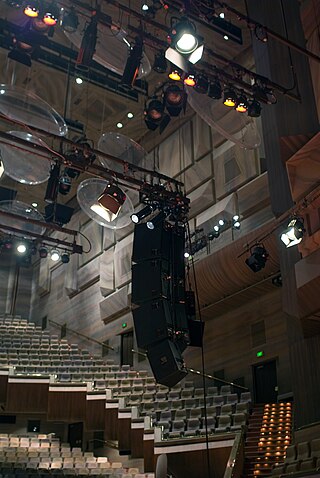Related Research Articles

The American National Standards Institute is a private nonprofit organization that oversees the development of voluntary consensus standards for products, services, processes, systems, and personnel in the United States. The organization also coordinates U.S. standards with international standards so that American products can be used worldwide.

Acoustics is a branch of physics that deals with the study of mechanical waves in gases, liquids, and solids including topics such as vibration, sound, ultrasound and infrasound. A scientist who works in the field of acoustics is an acoustician while someone working in the field of acoustics technology may be called an acoustical engineer. The application of acoustics is present in almost all aspects of modern society with the most obvious being the audio and noise control industries.

In music, timbre, also known as tone color or tone quality, is the perceived sound quality of a musical note, sound or tone. Timbre distinguishes different types of sound production, such as choir voices and musical instruments. It also enables listeners to distinguish different instruments in the same category.

Film speed is the measure of a photographic film's sensitivity to light, determined by sensitometry and measured on various numerical scales, the most recent being the ISO system introduced in the mid-1970s. A closely related ISO system is used to describe the relationship between exposure and output image lightness in digital cameras. Prior to ISO gaining traction the best known systems were ASA in the U.S. and DIN in Europe.

The phon is a logarithmic unit of loudness level for tones and complex sounds. Loudness is measured in sones, a linear unit. Human sensitivity to sound is variable across different frequencies; therefore, although two different tones may present an identical sound pressure to a human ear, they may be psychoacoustically perceived as differing in loudness. The purpose of the phon is to provide a logarithmic measurement for perceived sound magnitude, while the primary loudness standard methods result in a linear representation. A sound with a loudness of 1 sone is judged equally loud as a 1 kHz tone with a sound pressure level of 40 decibels above 20 micropascal. The phon is psychophysically matched to a reference frequency of 1 kHz. In other words, the phon matches the sound pressure level (SPL) in decibels of a similarly perceived 1 kHz pure tone. For instance, if a sound is perceived to be equal in intensity to a 1 kHz tone with an SPL of 50 dB, then it has a loudness of 50 phons, regardless of its physical properties. The phon was proposed in DIN 45631 and ISO 532 B by Stanley Smith Stevens.

Acoustical engineering is the branch of engineering dealing with sound and vibration. It includes the application of acoustics, the science of sound and vibration, in technology. Acoustical engineers are typically concerned with the design, analysis and control of sound.

In acoustics, loudness is the subjective perception of sound pressure. More formally, it is defined as the "attribute of auditory sensation in terms of which sounds can be ordered on a scale extending from quiet to loud". The relation of physical attributes of sound to perceived loudness consists of physical, physiological and psychological components. The study of apparent loudness is included in the topic of psychoacoustics and employs methods of psychophysics.

The Acoustical Society of America (ASA) is an international scientific society founded in 1929 dedicated to generating, disseminating and promoting the knowledge of acoustics and its practical applications. The Society is primarily a voluntary organization of about 7500 members and attracts the interest, commitment, and service of many professionals.

A sound level meter is used for acoustic measurements. It is commonly a hand-held instrument with a microphone. The best type of microphone for sound level meters is the condenser microphone, which combines precision with stability and reliability. The diaphragm of the microphone responds to changes in air pressure caused by sound waves. That is why the instrument is sometimes referred to as a sound pressure level meter (SPL). This movement of the diaphragm, i.e. the sound pressure, is converted into an electrical signal. While describing sound in terms of sound pressure, a logarithmic conversion is usually applied and the sound pressure level is stated instead, in decibels (dB), with 0 dB SPL equal to 20 micropascals.
The Journal of the Acoustical Society of America (JASA) is a monthly peer-reviewed scientific journal covering all aspects of acoustics. It is published by the Acoustical Society of America and the editor-in-chief is James F. Lynch. JASA contains news items, book reviews, references to contemporary papers, reviews of acoustical patents, and standards news.

Underwater acoustics is the study of the propagation of sound in water and the interaction of the mechanical waves that constitute sound with the water, its contents and its boundaries. The water may be in the ocean, a lake, a river or a tank. Typical frequencies associated with underwater acoustics are between 10 Hz and 1 MHz. The propagation of sound in the ocean at frequencies lower than 10 Hz is usually not possible without penetrating deep into the seabed, whereas frequencies above 1 MHz are rarely used because they are absorbed very quickly.
The ASA Silver Medal is an award presented by the Acoustical Society of America to individuals, without age limitation, for contributions to the advancement of science, engineering, or human welfare through the application of acoustic principles or through research accomplishments in acoustics. The medal is awarded in a number of categories depending on the technical committee responsible for making the nomination.
The following outline is provided as an overview of and topical guide to acoustics:

In physics, sound is a vibration that propagates as an acoustic wave through a transmission medium such as a gas, liquid or solid. In human physiology and psychology, sound is the reception of such waves and their perception by the brain. Only acoustic waves that have frequencies lying between about 20 Hz and 20 kHz, the audio frequency range, elicit an auditory percept in humans. In air at atmospheric pressure, these represent sound waves with wavelengths of 17 meters (56 ft) to 1.7 centimeters (0.67 in). Sound waves above 20 kHz are known as ultrasound and are not audible to humans. Sound waves below 20 Hz are known as infrasound. Different animal species have varying hearing ranges.
In science and engineering, a power level and a field level are logarithmic magnitudes of certain quantities referenced to a standard reference value of the same type.
ANSI S1.1-1994, published by American National Standards Institute (ANSI), is an American National Standard on Acoustical Terminology. It is superseded by ANSI/ASA S1.1-2013.

Gordon Eugene Martin is an American physicist and author in the field of piezoelectric materials for underwater sound transducers. He wrote early computer software automating iterative evaluation of direct computer models through a Jacobian matrix of complex numbers. His software enabled the Navy Electronics Laboratory (NEL) to accelerate design of sonar arrays for tracking Soviet Navy submarines during the Cold War.

A one-third octave is a logarithmic unit of frequency ratio equal to either one third of an octave or one tenth of a decade. An alternative (unambiguous) term for one tenth of a decade is a decidecade.
Ma Dayou or Dah-You Maa was a Chinese acoustical physicist, specializing in various aspects of acoustics, especially sound generation, transmission and absorption. Academician of Chinese Academy of Sciences (CAS), Ma was a research professor at Institute of Acoustics of CAS; Chairman of Chinese National Acoustics Standardization Technical Committee; and Editor-in-Chief of Chinese Journal of Acoustics.
The Institute of Acoustics of the Chinese Academy of Sciences (CAS) was established in 1964 by the Chinese government in the context of China's national defense needs for acoustic research, under the auspices of Marshall Nie Rongzhen.
References
- ↑ "AMERICAN NATIONAL STANDARD Acoustical Terminology" (PDF). Archived from the original (PDF) on 2014-03-08. Retrieved 2014-03-08.
- ↑ Ainslie, M. A. A Century of Sonar: Planetary Oceanography, Underwater Noise Monitoring, and the Terminology of Underwater Sound. Acoustics Today (February, 2015)